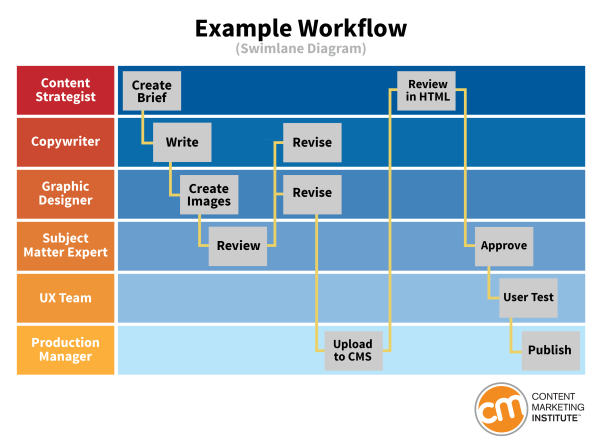Content creation workflow is the process of breaking down content creation into smaller tasks. Each task has a dedicated person within the team responsible for the particular step within the workflow. This method makes content more manageable and easier to track.
Content workflow is especially helpful for complex strategies where published pieces have more than one marketing goal. It minimizes the chance of a mistake and facilitates time and resource-efficient work processes.
The guide below describes content creation workflow and provides practical tips for marketers and content creators.
What is Content Creation Workflow?
It is a document that illustrates the entire process of content creation – from ideation to publication. The document assigns tasks to different responsible parties, sets timeframes, and allocates resources needed for each task.
The number of participants within the workflow pipeline differs according to the purpose of the content, as well as the overall size of the marketing team. Similarly, depending on the content marketing goals, workflow may include as few as 5 tasks or as many as 20+ tasks.
The process breakdown
Imagine, we want to write an article about the effects of plastic pollution on marine ecosystems. The goal of this article is to rank on the first page in Google for related keywords. We also want researchers and academic writers to find our article and cite it in their works. For this purpose, we need 6 team members participating in the workflow:
- Content strategist – brainstorming, keyword research, content brief
- Copywriter – content marketing best practices, content creation, revision
- Graphic designer – infographics, visual media (videos, images), revision
- Subject expert – revising copywriters’ and graphic designers’ work
- UX team – user testing for the new content
- Production manager – uploading to CMS, publishing


Content Strategist
The process starts with a content strategist brainstorming article elements, researching keywords and top-ranking pages. They create a content brief outlining article structure, keywords, headings, citations, and writer guidelines.
Copywriter
Copywriters follow the strategist’s brief and research the topic, reading academic material and top-ranking articles. They choose the style and tone based on best practices. The content writer revises the article after the strategist and subject expert review it.
Graphic Designer
Graphic designers are sometimes needed for the workflow, depending on the content requirements. A content strategist determines if special media resources like infographics, clipart, or videos are necessary. The graphic designer then creates these visuals based on the content strategist’s instructions and passes them to the subject expert for review.
Subject Expert
A subject matter expert is an expert on the article’s topic. They check the article for accuracy, suggest improvements, and their recommendations are sent to the content strategist for approval before being passed on to the copywriter and graphic designer for revisions.
UX Team
The User Experience team is responsible for making sure that the new piece of content looks good on the website and does not disrupt the UX of the page. Especially, if there is a large amount of media present within the article, the UX team checks if the elements load on time on a screen. Sometimes, user experience teams conduct A/B testing on different content page drafts to find out which one works the best.
Production Manager
A production manager is a person responsible for completing the final step of content creation workflow. Once all responsible team members review their work and update the document, the content strategist approves the article for publication. Now, depending on the roles of production managers, they may need to do several things before they publish, such as inserting internal links, uploading the media, formatting the article (headings, bullet points), or none of it.
Task-based vs Status-based Workflows
Typically, content creation workflows have two strategies:
- Task-based workflow
- Status based workflow
Both are very efficient methods in digital content marketing strategy, however, must be carefully chosen for the team culture and assembly.
Task-based Workflow
This methodology is usually suitable for new content teams that need detailed planning and guidance throughout the process. Task-based workflows contain well-described steps with detailed instructions on how and when to complete the tasks. Following our example earlier, it may look like this:
- Content Strategist (deadlines, tools to use + instructions for each step):
- Brainstorming (brainstorm the article content, style, structure)
- Keyword research (find focus and secondary keywords)
- Competitor research (analyze top 10 ranking websites for the same topic)
- Outline (plan sections and subsections)
- Brief (design a content brief for copywriters and graphic designers)
- Copywriter (deadlines, tools to use + instructions for each step)
- Research (analyze the top 10 articles on the same topic)
- Draft (write the first version of the content)
- Keyword implementation (inserting the keywords as per keyword density within the brief)
- Links (put citations and internal links)
- Grammar check (making sure there are no mistakes and the readability score is satisfactory)
- Graphic designer (deadlines, tools to use + instructions for each step)
- Research (check the visuals of competitor websites)
- Design (design the media by the brief)
- Review (revise the media according to the content strategist’s and subject expert’s suggestions)
- Subject Expert (deadlines, tools to use + instructions for each step)
- Check the data (make sure numbers and stats are correct)
- Check the sources (identify reliable and academic sources)
- Suggestions (write suggestions for improving the article content)
- UX team (deadlines, tools to use + instructions for each step)
- Analyze current UX (make sure that the content does not disrupt user experience in content)
- Suggest improvement (recommend elements that improve UX)
- Conduct A/B testing (once the article is ready, conduct A/B tests on UX elements)
- Production Manager (deadlines, tools to use + instructions for each step)
- Upload to CMS (check that the article is not missing any important elements + SEO checklist)
- Publish the article
Status-based Workflow
Status-based workflows are ideal for teams that have been working together for quite some time. They already have experience of collaboration with each other and know the specifics of content creation workflow. Hence, this method requires fewer details and provides more freedom for creative work.
Status-based workflow may look like this:
- New task (assigned to content strategist)
- First draft (assigned to copywriter and designer)
- In-review (assigned to subject expert and content-strategist)
- Approved/Revising (assigned to content strategist, or copywriter & graphic designer and then to UX team)
- Publishing (assigned to production manager)
Content Creation Workflow Platforms
The process outlined above can be conducted manually or with the help of specific platforms. Workflow platforms allow marketing and content teams to create new tasks, assign responsibilities, add sub-tasks, set deadlines, and evaluate performance. It is easier to track the progress of the content on such platforms than when it is done manually (for example in Excel).
Here are some of the best content creation workflow platforms:
- GatherContent – the platform allows copywriters and editors to write and edit directly within the platform’s editor. GatherContent also has task automation features and stores all content in a centralized location. The cheapest plan starts at $99 per month.
- ClickUp – the platform offers more than 50 preset triggers and conditions for task automation along with pre-developed workflow templates. It is a very useful tool for new content teams with over 1000 integrations. The cheapest paid plan starts at $9 per member per month.
- Monday – Monday is one of the best work management platforms with the simplest interface available on the market. It includes more than 200 workflow templates, customized dashboards, and reports for tracking the return on investment of any content piece. The cheapest paid plan starts at $10 per user per month.
- Contently – Contently is an amazing opportunity for SEO-centric content teams. This platform allows keyword research and long-form content SEO optimization with its strategy recommendations. Furthermore, the platform has an analytics suite and automation benefits.





















Leave a Reply
View Comments